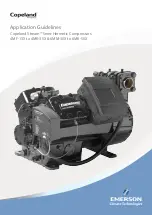
Also consult following safety precautions:
Safety precautions during operation
and
Safety
precautions during maintenance
.
These precautions apply to machinery processing or consuming air or inert gas. Processing
of any other gas requires additional safety precautions typical to the application which are not
included herein.
Some precautions are general and cover several machine types and equipment; hence some
statements may not apply to your machine.
1.4
Safety precautions during operation
All responsibility for any damage or injury resulting from neglecting these
precautions, or non-observance of the normal caution and care required for
installation, operation, maintenance and repair, even if not expressly stated, will
be disclaimed by the manufacturer.
Precautions during operation
1. Never touch any piping or components of the compressor during operation.
2. Use only the correct type and size of hose end fittings and connections. When blowing through a hose or
air line, ensure that the open end is held securely. A free end will whip and may cause injury. Make sure
that a hose is fully depressurized before disconnecting it.
3. Persons switching on remotely controlled machines shall take adequate precautions to ensure that there
is no one checking or working on the machine. To this end, a suitable notice shall be affixed to the remote
start equipment.
4. Never operate the machine when there is a possibility of taking in flammable or toxic fumes, vapors or
particles.
5. Never operate the machine below or in excess of its limit ratings.
6. Keep all bodywork doors shut during operation. The doors may be opened for short periods only, e.g. to
carry out routine checks. Wear ear protectors when opening a door.
7. People staying in environments or rooms where the sound pressure level reaches or exceeds 90 dB(A)
shall wear ear protectors.
8. Periodically check that:
• All guards are in place and securely fastened
• All hoses and/or pipes inside the machine are in good condition, secure and not rubbing
• There are no leaks
• All fasteners are tight
• All electrical leads are secure and in good order
• Safety valves and other pressure-relief devices are not obstructed by dirt or paint
• Air outlet valve and air net, i.e. pipes, couplings, manifolds, valves, hoses, etc. are in good repair, free
of wear or abuse
9. If warm cooling air from dryers is used in air heating systems, e.g. to warm up a workroom, take precautions
against air pollution and possible contamination of the breathing air.
10. Do not remove any of, or tamper with, the sound-damping material.
11. Never remove or tamper with the safety devices, guards or insulations fitted on the machine. Every pressure
vessel or auxiliary installed outside the machine to contain air above atmospheric pressure shall be
protected by a pressure-relieving device or devices as required.
Instruction book
2920 1818 00
7
Summary of Contents for QED 650
Page 5: ...9 Pressure equipment directives 96 Instruction book 4 2920 1818 00...
Page 12: ...General view of QED 850 Instruction book 2920 1818 00 11...
Page 14: ...Position of components Inside view of QED 650 Instruction book 2920 1818 00 13...
Page 15: ...Inside view of QED 850 Instruction book 14 2920 1818 00...
Page 26: ...Electrical diagram QED 650 Instruction book 2920 1818 00 25...
Page 27: ...Electrical diagram QED 850 and QED 1050 Instruction book 26 2920 1818 00...
Page 78: ...Dimension drawing of QED 850 Instruction book 2920 1818 00 77...
Page 98: ......
Page 99: ...Cod 2920 1818 00 Edition 09 2012 quincycompressor com info quincycompressor com 217 222 7700...









































